Your earned media strategy matters more than ever, especially now that LLMs consider web mentions to be a key indicator of credibility. But if you’re using the traditional PR playbook to get placement in major publications and it’s not working, that’s no surprise. Editors get flooded, timelines move fast, and attention spans are shrinking. Standing out is harder than ever, so it may be time to use Publication-Tailored Content (PTC), a better strategy to get coverage.
PTC allows you to collaborate with publishers to create content together. Instead of begging publishers to look at your content, this approach guarantees placement, increases your reach, and helps you build relationships with key publications. It’s a win-win all around.
If your earned media strategy feels stagnant, this is how PTC can change everything. But first, let’s talk about why traditional earned media doesn’t work the way it used to.
Why Your Earned Media Coverage Strategy Doesn’t Work
Distribution has changed radically in the last decade. Digital marketing, social platforms, SEO, and AI have reshaped how brands plan, publish, and measure across paid, owned, and earned channels. What used to take off on one platform with a single asset now needs a multi-channel strategy with a strong distribution plan.
Although there are more ways for people to consume content than ever, earned media still pulls weight, as 78% of marketers say earned media is more effective than traditional advertising. Getting coverage is just harder now, for multiple reasons.
- Oversaturation: 49% of journalists say they get at least 6 pitches a day—others get more than 21 a day. The bar to impress is high.
- Weak pitches: Long press releases and stale formats still clog inboxes. Editors often notice bad pitches for the wrong reasons.
- Bad content: With the proliferation of AI, journalists are inundated with AI-generated pitches that are generic and irrelevant.
- Overly branded content: Weak stories, logo overload, and forced brand mentions also turn editors off. Even decent content gets rejected if it’s stale, overdone, or off-beat.
In general, the biggest issue is that the content doesn’t align with the reader. Journalists are the gatekeepers, curating and creating content for a specific audience. Thus, the story has to start with the reader.
Before you pitch, you need to lay the groundwork.
1) Understand what the audience wants.
Brands often chase prestige in placement because, yes, getting featured in Time sounds great. But your pitch should cater to the publication’s audience. Build content people want to share, and your reach will grow where it counts. To do that well, you need to study what their audience wants and what they return to. This mindset also helps you narrow your target publication list.
2) Build collaborative relationships.
Editors want work that lands with their readers and makes their own coverage stronger. Beyond researching what content has traditionally performed well, having a direct line to journalists eliminates that guesswork. Keep a clean contact list, track beats, and share ideas that feel useful and timely. That simple structure lifts the chance of real earned mentions. Pro tip: Use platforms like Featured, which allow you to submit guest expert quotes for articles. This helps you get your expertise out there and build a reputation as a go-to expert for journalists.
When you have that clarity and relational foundation, then you can pursue a successful Publication-Tailored Content strategy.
What Is Publication-Tailored Content?
PTC is the reverse of traditional pitching. Instead of finishing content and hoping it sticks, you co-create with the publisher from the start. By bringing the editor in early, aligning on audience needs, and customizing the content, the final product is a perfect fit for topic, tone, and format.
PTC is a true collaboration from ideation through creation:
- Ideas are vetted with the publisher, and often originate with them.
- Content is crafted and formatted to fit the publication’s look and standards.
- Editorial teams review iterations to steer accuracy and tone.
- The piece is published and typically co-branded, helping bring awareness to your brand and elevating your reputation.
This model works because it respects every stakeholder: the brand, the publisher, and the reader.
Brand benefits
- Better ROI: Higher odds of placement mean time and budget go toward work that ships and gets seen, driving leads, signups, or sales.
- Larger reach: Coverage unlocks bigger and more relevant groups of readers who are already primed for your topic.
- Higher SEO/AEO traffic: Links from strong domains compound results, increasing your rankings.
- Credibility: Appearing in respected outlets signals expertise. Third-party validation boosts trust, which is especially important for LLM visibility.
- Continued collaboration: Delivering value turns a one-off into a steady pipeline as editors come back with new asks when the work performs well.
Case study: Column Five partnered with Microsoft Social Listening to create a PTC series for its social listening tool. Publishing partners helped pinpoint timely topics with share potential. The result: placements that exceeded goals for coverage, traffic, conversions, and visibility.
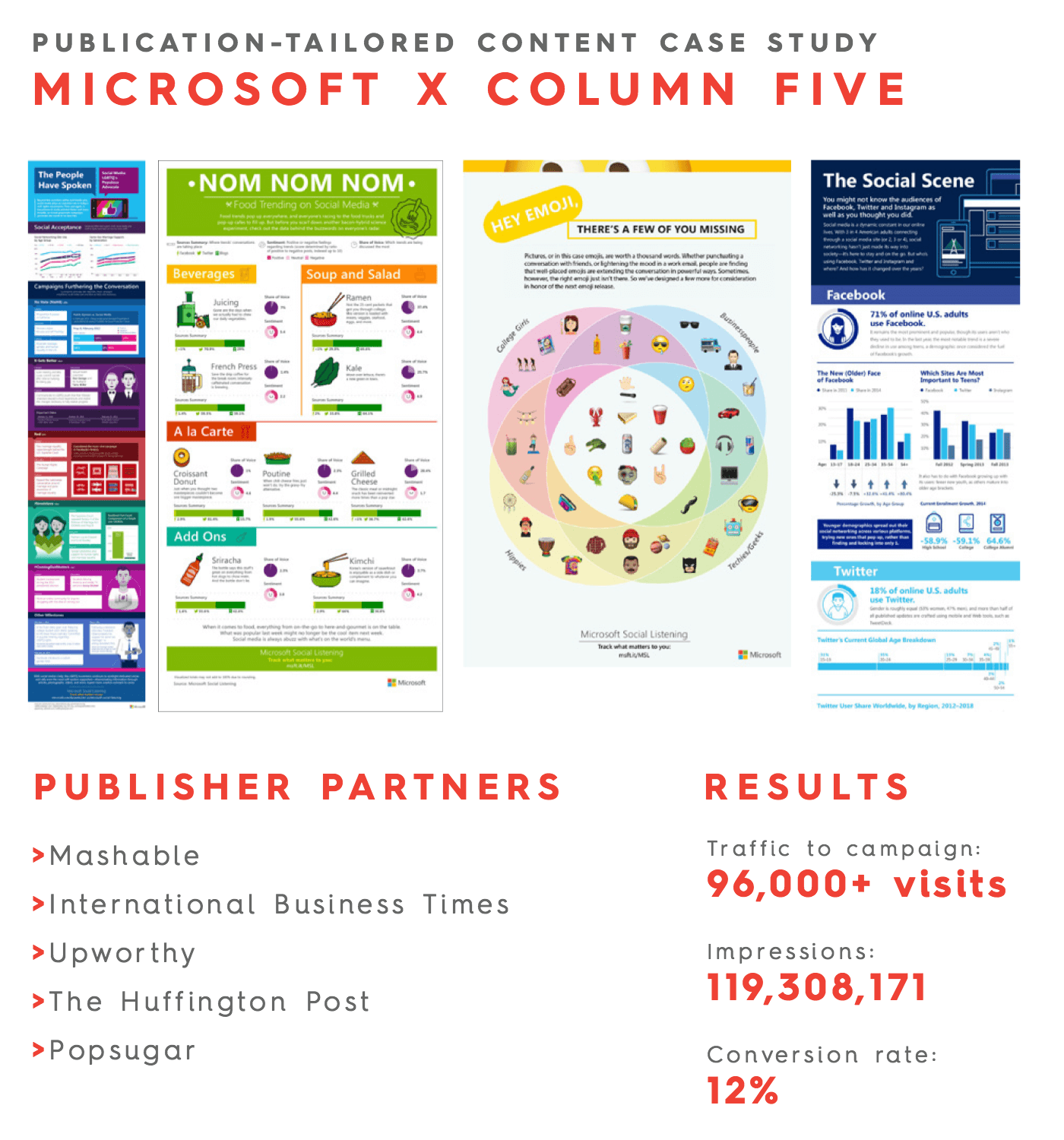
Publisher benefits
- Free content: High-quality pieces without tapping internal bandwidth.
- Relevant content: According to Cision, journalists say only 7% of pitches are relevant to their beat. With PTC, they shape the piece upfront so it is a slam dunk.
- Diversity: Formats like interactives, infographics, and video keep coverage fresh.
- Exclusivity: Custom, exclusive content gives the publisher an edge and can spark additional pickup and mentions for both sides.
Case study: Column Five and Addvocate partnered on a PTC piece for Mashable: an interactive poll on how readers pronounce tech terms. Mashable engaged its community, tested a new format, and captured proprietary data.
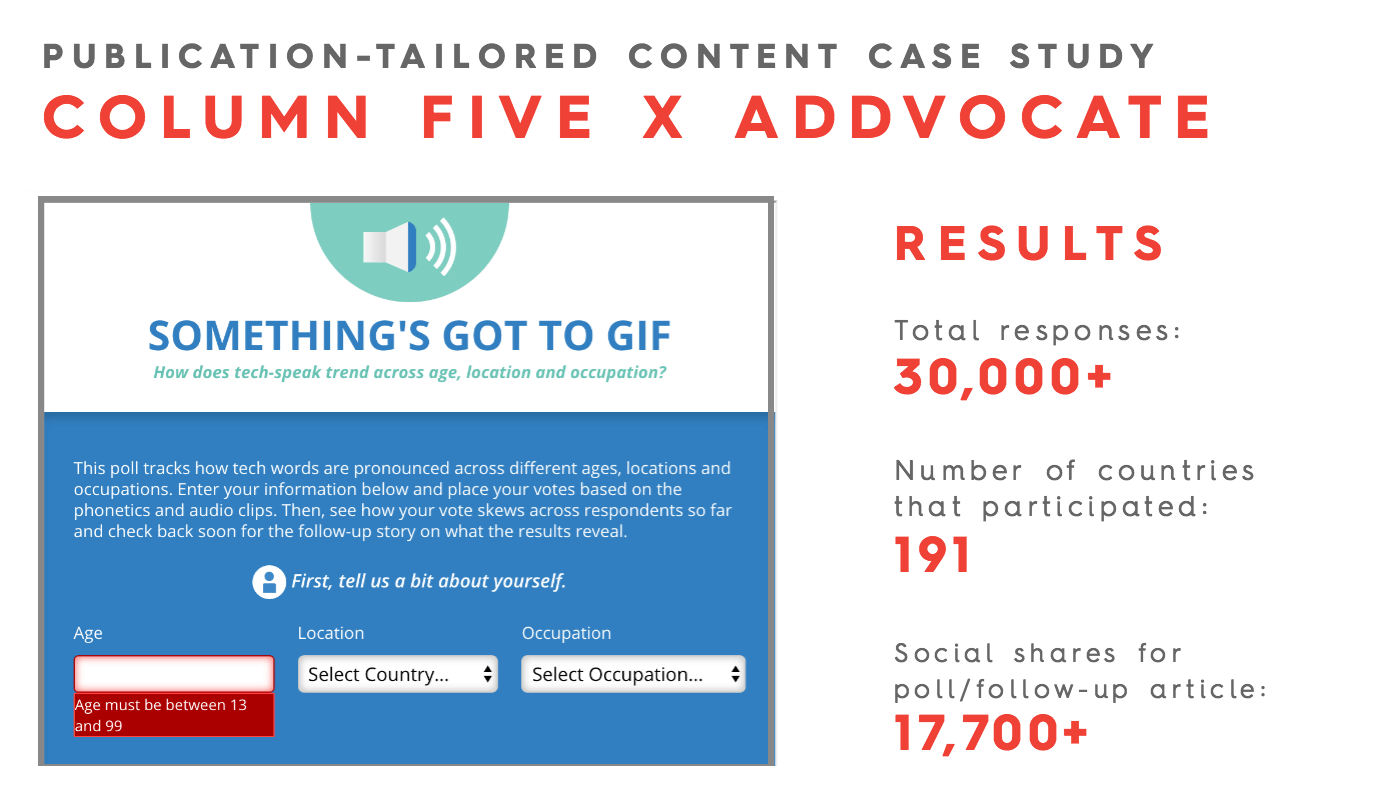
Audience benefits
- Engaging storytelling: Strong data visualization or snackable visuals deepen understanding and keep people reading.
- Brand expertise: Subject-matter depth makes the piece useful. Third-party coverage boosts perceived credibility.
- Brand discovery: People prefer stories over sales copy. When the topic is fresh and helpful, they stick around.
Example: Column Five partnered with NewsCred on a PTC infographic unpacking Snapchat users. Marketers got practical insights. Multiple outlets picked it up, which extended reach well beyond the initial placement. Social mentions then amplified it further.
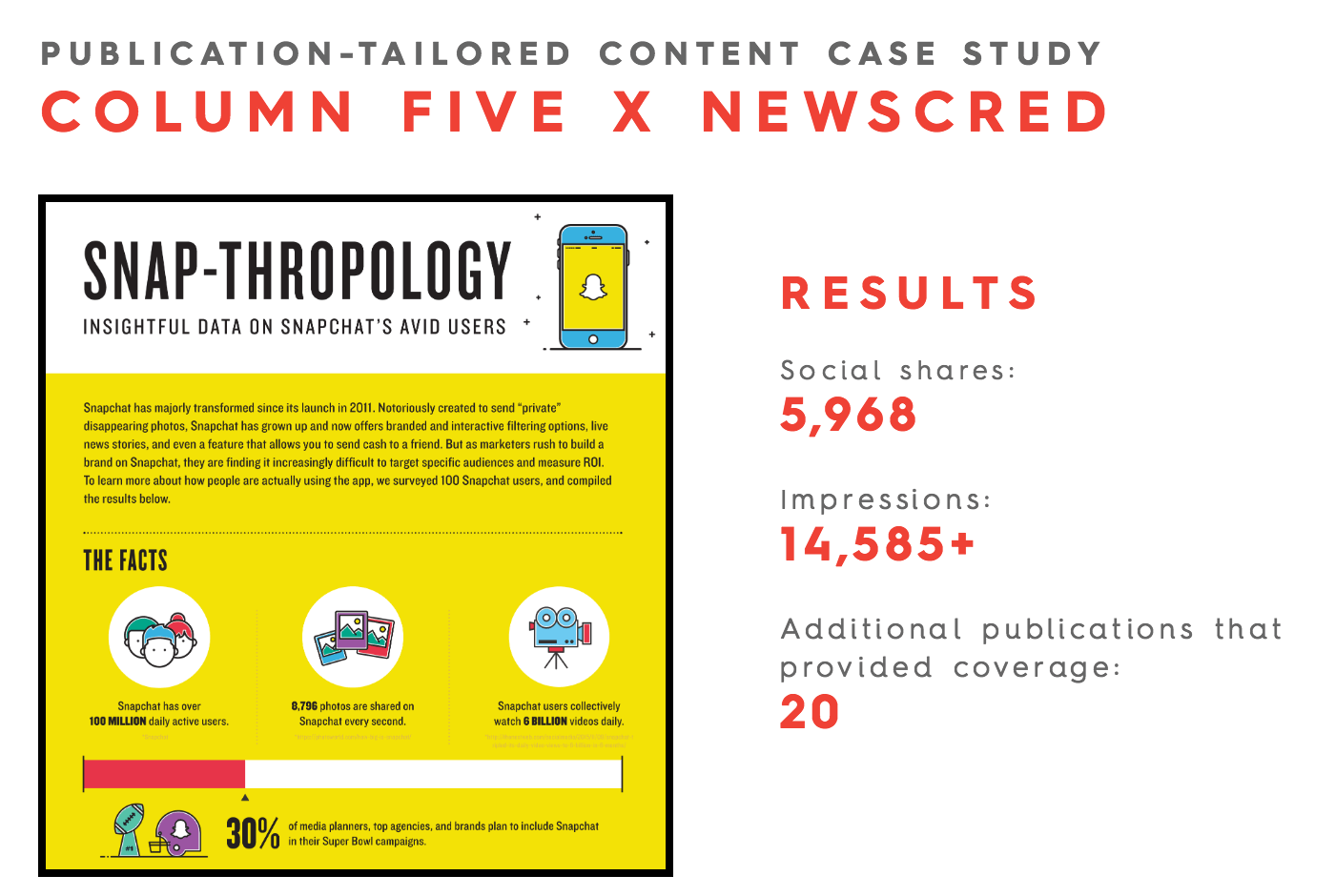
How to Put PTC Into Practice
PTC works best with established relationships. The steps below assume a foundation with editors. (If you need a jumpstart in identifying potential publications, finding the right people, and building rapport, see this guide.) Although PTC isn’t always guaranteed to publish (due to shifting timelines or priorities in the publication world), it is your best bet for earning the coverage you want. Here’s how to do it.
1) Invite publishers into the creation process.
PTC needs willing collaboration, so bring everyone in early.
Kick things off with a quick exploratory phase. Set a short call or send a tight email to ask what they want more of and what formats are interesting right now. The offer is simple: provide high-value content their readers will appreciate.
Tip: Editorial interns can be great first contacts. They review more ideas, have energy for new formats, and can champion a smart concept.
Ask questions like:
- What topics do your readers respond to most?
- Any upcoming stories that would benefit from supporting visuals or data?
- Which formats are you interested in (infographics, interactive content, videos)?
- What do you wish you could explore but never have time for?
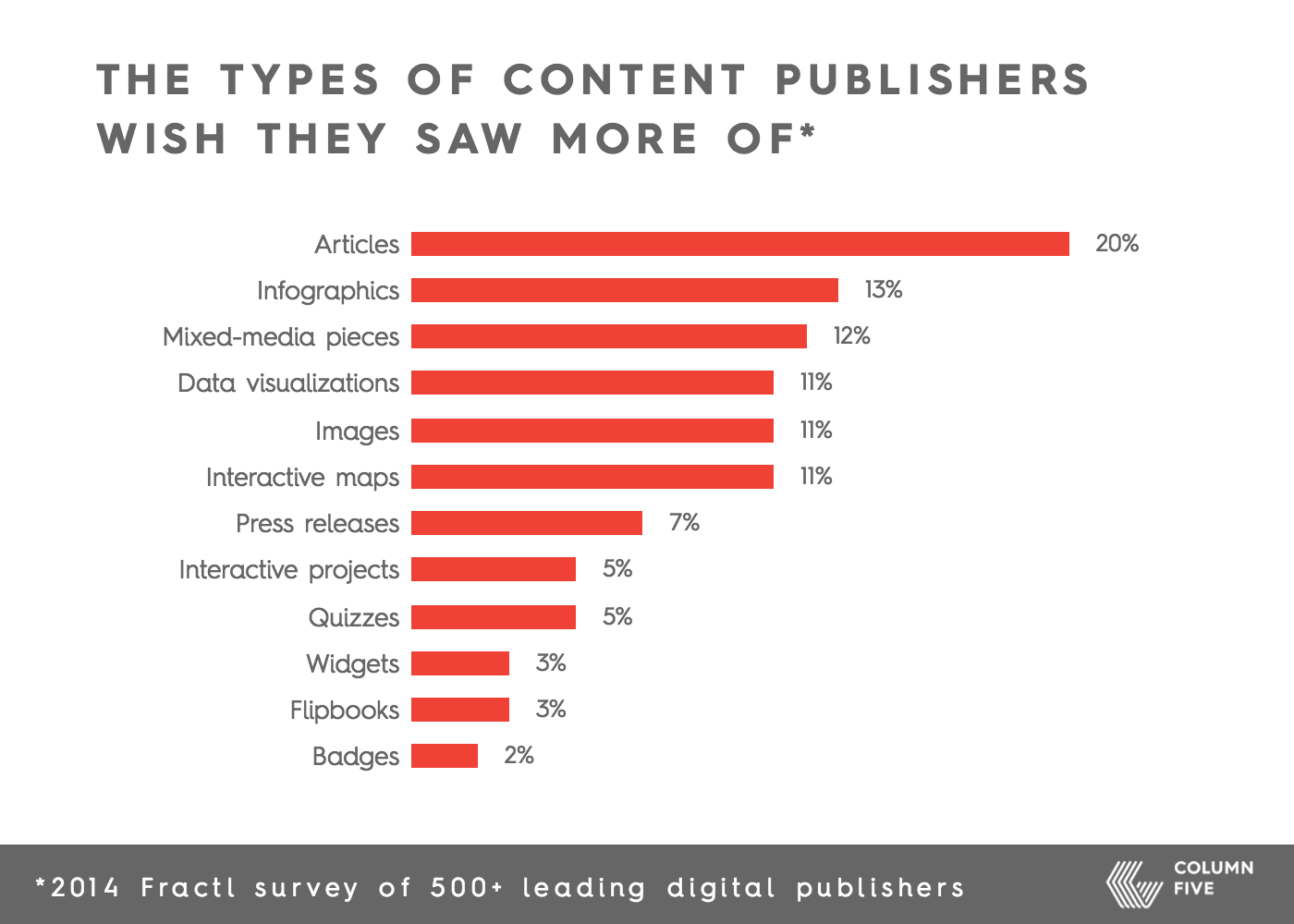
Aim to land on a compelling idea. Editors often gravitate to:
- Research or studies
- Proprietary data
- Industry expertise or insights
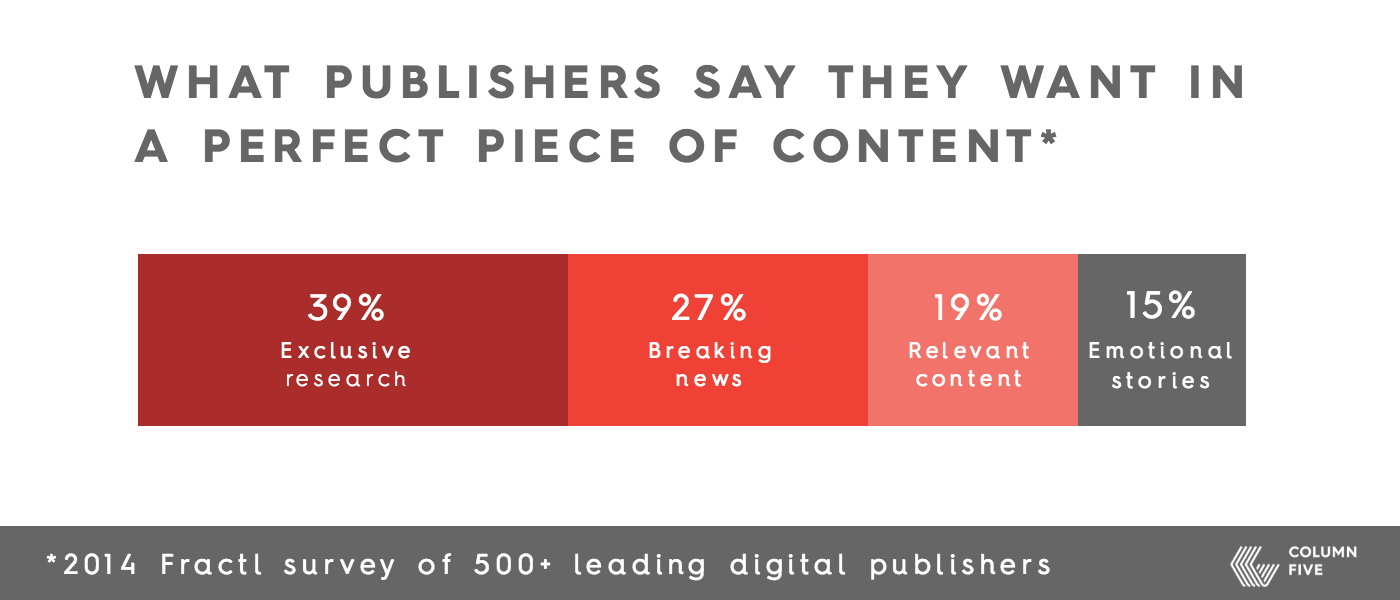
Sometimes an editor has a clear request. Other times, they offer freedom to experiment. Many standout PTC projects started with an editor saying, “Go weird. Try something new.”
But keep ideas rooted in the publication’s reader and voice. When the concept feels tight, circle back for feedback and alignment on:
- Content: Medium, story, length
- Design: Dimensions, file format, brand elements
- Promotion: Timeline, publish date, exclusivity
With a green light, move into production.
2) Create the content.
Involvement varies. Some editors help outline and source. Others prefer to react to drafts. Ask where they want to weigh in, then set check-in points.
Share progress at useful milestones (e.g., outline, wireframe, design rounds) so feedback lands early and the piece stays on course.
Before sending anything, tighten the work:
- Content: Is the story clear and complete? Does tone match the publication? Are facts checked and sources solid?
- Design: Does it fit the subject and the outlet’s standards? Does it adhere to brand guidelines?
If you’re new to PTC, stay open to edits. Showing you’re easy to work with builds trust and leads to the next collaboration.
Once the piece runs, share across your owned channels (e.g., site, newsletter, and social profiles ) to extend visibility and meet readers where they already follow you. These controlled touchpoints keep messaging aligned and improve discovery.
3) Nurture your relationships with publishers.
Good work opens doors. Keep showing up:
- Track what each publication is covering and which formats they’re trying.
- Watch content trends and refresh ideas often. Some teams pair earned wins with paid promotion to reach more people.
- Ask how the piece performed. What did readers do? What did the team notice internally?
- Keep the relationship human. Talk shop—and sometimes not about work at all.
4) Be prepared to pivot.
A few realities to plan for:
- Some publishers may not collaborate. Policies or native guidelines can block that path. No problem—move to outlets that value co-creation.
- It takes time. Relationships, brainstorming, wrangling stakeholders, and rounds of edits all take effort, so plan timelines with room for review.
- It requires resources. Don’t overpromise. Pitch only what you can deliver well and on time.
- It might not get published. Contacts change roles. Priorities shift even after approval. If a piece fits one outlet, it likely fits another. Paid media offers more predictable placement and message control, though it won’t deliver the same organic lift in search or word-of-mouth.
Like the rest of the Internet, earned media shifts constantly. What worked last quarter may not work this quarter. Stay close to editors, keep learning from results, and keep the dialogue open. New ideas surface that way.
(For more on planning and promotion, see our ultimate guide to content distribution.)
Measuring and Analyzing Results of Publication-Tailored Content
Measurement turns a good tactic into a reliable engine. Earned media isn’t as immediate as paid, and control is limited, but the upside—credibility, reach, and trust—is hard to match. In fact, the biggest benefit is the trust you can’t buy.
That said, you should track success. Use social listening to monitor sentiment, engagement, brand mentions, etc., across channels. Share those results with your contacts to leverage that success into a new piece of PTC.
You should also apply learned insights to your next idea. Going forward, study your own analytics as well as other media examples—articles, social posts, and user content—to pinpoint which content actually moves behavior. (You can also support your PTC with additional shareable content that invites conversation across other channels.)
Most importantly, know that PTC is only one part of the mix. A strong distribution strategy spans owned, earned, and paid, and requires the right allocation of resources to get the best ROI. We know building that strategy can be challenging, and an expert perspective can help. If you need support with any aspect of your content or distribution strategy, chat with our team about how we can help you reach the right people on the right channels.




